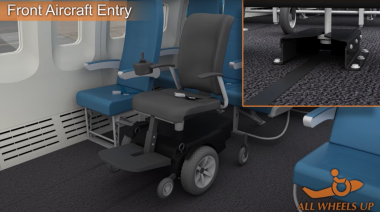All Wheels Up Brings Wheelchair-accessible Planes One Step Closer

Flying can be an ordeal for many people with disabilities who rely on wheelchairs to get from point A to point B. Sometimes disabled travelers get to their destination only to realize their wheelchair or scooter is broken or missing.
In 2019, the year after airlines were required to release statistics on mishandled wheelchairs following the Federal Aviation Administration (FAA) Reauthorization Act of 2018, the Department of Transportation (DOT) reported that more than 10,000 mobility devices were mishandled.
According to a DOT study released in January, 25.5 million people have disabilities that limit their travel. And 11% of them are wheelchair users.
Travel blogger Cory Lee, who relies on a power wheelchair because he has spinal muscular atrophy (SMA) type 2, has had plenty of wheelchair mishaps in visiting 39 countries across all seven continents.
When he flew home into Atlanta Hartsfield-Jackson international airport this summer, his wheelchair was so damaged he couldn’t even drive it. That’s not the first time it’s happened, either. Lee counts himself lucky his chair hasn’t been inoperable when disembarking at an international destination, but it’s always in the back of his mind.
“When I’m traveling throughout the entire flight, I’m dreading arriving at the destination and fear that my wheelchair will be damaged,” Lee, 31, said in an interview with SMA News Today.

All Wheels Up design mockup for a designated wheelchair spot on an aircraft. (Photo courtesy of All Wheels Up)
The organization All Wheels Up is imagining a future in which wheelchair users can simply drive their devices onto the plane and lock them with a restraint system similar to ones used in buses, trains, and cars.
“Our doors will not close until there is a device that can be used as a lockdown system, wheelchairs that are considered FAA-approved, an evacuation plan that’s set out for all people with disabilities, not just wheelchair users,” said founder and president Michele Erwin who has a 14-year-old son with SMA type 2, in a video interview with Bionews, the publisher of this website.
Erwin, who still works full time in the fashion industry, started the organization in 2011 after she and her family were grounded by her son’s diagnosis because it was too risky for them to fly. It forced them to pass on his Make-A-Wish trip to Japan.
All Wheels Up was created to fund the first successful crash test of wheelchairs and securement systems, which occurred in 2016. It took at least $70,000 and years of work, which included the design of a sled to hold wheelchairs for FAA testing, procurement of a pallet of wheelchair securement systems and a surrogate wheelchair, and travel to Washington, D.C., to raise awareness about the organization’s work.
In 2019, All Wheels Up conducted another test with a real wheelchair. It met the FAA standards of being able to withstand 16 G-forces.
Erwin hoped her efforts would lead the U.S. Congress to fund research and development of a dedicated spot for a wheelchair on planes. It would negate the dangerous transfer process, eliminate the potential of the chair being damaged in the cargo hold, and allow people with disabilities to travel worry-free.
That goal was partially met last month when the Transportation Research Board (TRB) released its report, “Technical Feasibility of a Wheelchair Securement Concept for Airline Travel.” The authors concluded that adding a wheelchair space to planes was indeed feasible, yet more crash testing and a strategic roadmap that will take into account variables — such as economic impact, evacuation plans, and standards for the kind of wheelchairs that can be used in the proposed system — would be necessary.
All Wheels Up asked Congress for $1.4 million to fund a feasibility study that would include crash tests via the FAA Reauthorization Act of 2018; however, it settled on $700,000 for a feasibility study without physical testing. The organization presented to the study committee during its listening sessions and presented 70 pages of research it had done to date.
So even though Congress took a step in the right direction, there’s plenty more for Erwin to work on, she said.
“If we leave it up to the government, it’s going to take forever,” Erwin said.
All Wheels Up is rapidly moving up the runway, already moving forward on what was suggested in the TRB report. A University of Washington roadmap study it funded is expected to be published June 3, 2022.
The university is part of the FAA Centers of Excellence in aviation research. It leads the Center for Advanced Materials in Transport Aircraft Structures under the Joint Advanced Materials and Structures Center of Excellence, which was established in 2003.
All Wheels Up funded another University of Washington capstone study, which looks into the budget impact model of adding a wheelchair spot to planes. Erwin is hoping the results of that study could be used as a marketing tool to raise money for a larger, four-year economic impact study.
“The budget impact model is going to be pretty broad scope in regards to not just looking at, oh, well, we’re taking away a row of seats. It’s way bigger conversation. We believe that the airline industry can actually increase their revenue if they provided a wheelchair spot on airplanes,” Erwin said.
It will take into consideration public relations nightmares of breaking a person’s wheelchair, the legal payouts for something like dropping someone during a transfer, luggage handlers out on disability for lifting 400-pound power wheelchairs, and savings in fuel because a wheelchair user would be able to board and exit the aircraft faster.
If those in wheelchairs were less fearful of their equipment being broken or being injured, there would be even greater demand for travel. Instead of a family driving to a destination because of wheelchair constraints, they would be buying plane tickets, advocates say.
“We’re trying to help build the disabled travel industry,” Alan Chaulet, chief operating officer of All Wheels Up and a Duchenne muscular dystrophy patient, said in a video interview. “There’s a lot of money that people with disabilities spend on travel and it could be much higher.”
In addition to advocating for wheelchair-accessible spots and funding research to get there, All Wheels Up is focusing on issues related to flying with a disability that can be alleviated in the near term.
Its Fly Safe Today program is giving away adult special needs harness so those with limited trunk support can be better secured in their seats and ADAPTS evacuation slings that can help crews safely transfer passengers with special needs in emergency situations. All Wheels Up bought the harnesses, which are not available online, wholesale from Kids Fly Safe, which also sells a children’s version of the product.
Most of the funding for All Wheels Up comes from grants; however, its 2021 Virtual Race, which occurred during National Aviation Week in August, helped raise additional money for the mission.
Airlines, disability advocates, and transportation experts have been talking about accessible air travel for the past 40 years. The Air Carrier Access Act, which says airlines cannot discriminate against people who have mental or physical disabilities, was enacted in 1986, four years prior to the Americans with Disabilities Act.
It’s taken four decades to get to this point partly because of a lack of funding for studies like the recent feasibility report and the complicated nature of using a personal wheelchair inside the confines of an airplane, according to Katharine Hunter-Zaworski, civil and construction engineering associate professor at Oregon State University and director of the National Center for Accessible Transportation.
Hunter-Zaworski, who also served on the committee of the recent TRB report, added that the FAA is highly regulated, making it a difficult environment to get something like a wheelchair spot approved. All wheelchairs that could be used in planes would have to be standardized like they are in motor vehicles, which would require cooperation between wheelchair manufacturers, airlines, and regulatory agencies.
“Wheelchairs are unique to their user in size, weight, and features, it is a complicated process to determine just what is feasible onboard an aircraft,” American Airlines said in a written statement to online science magazine Undark in 2019.
That’s not to mention the engineering hurdles, such as designing accessible lavatories and researching load distribution in the event of an emergency landing or survivable crash. The TRB report called for a crash test that will look into the vertical forces incurred on an aircraft, which All Wheels Up said it is prepared to do.
Hunter-Zaworski remains positive about the future of wheelchair spots on airplanes. In the next generation of airline bodies, it will be easier to design around a power wheelchair. And when interiors are redone, which typically occurs every seven to 10 years, wheelchair areas could be added.
Additionally, designing cargo doors that are big enough to fit wheelchairs through, tie-down systems in the cargo hold, and better coding of special service requests of people requiring assistance from the airline, are all things that can be done now to improve the travel experience for people with disabilities.
“I think we’re moving in the right direction. We have a lot of things happening at the federal level for the first time in years,” Hunter-Zaworski said, as the Air Carrier Access Amendments Act of 2021, which is stricter on discrimination based on disability and sets better standards for wheelchair users, was introduced this year in Congress. “I’m extremely optimistic about the future in this world.”
It’s nearly impossible to put a time frame on when Erwin’s dream will become a reality because it depends on many factors — including the airline’s willingness to work on furthering accessible travel, engineering hurdles, and how fast Congress moves on the issue. Whenever it does happen, it will open up the world for millions of people.
For blogger Lee, it will make airline travel so much easier.
“My biggest dream is to be able to just roll on the plane and stay in my wheelchair. I really cannot wait for that day,” Lee said.







